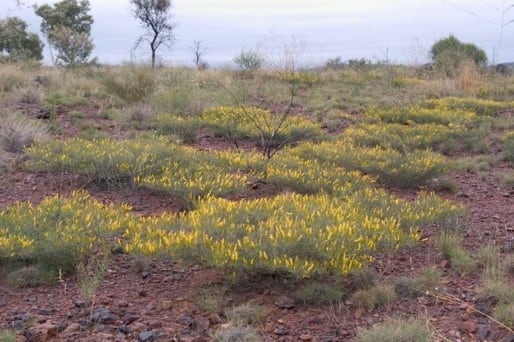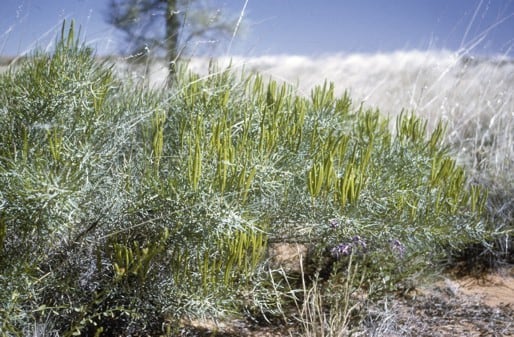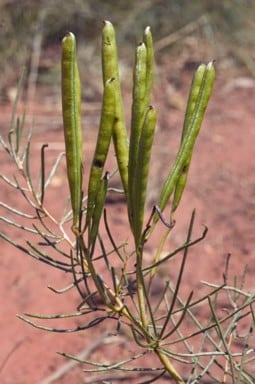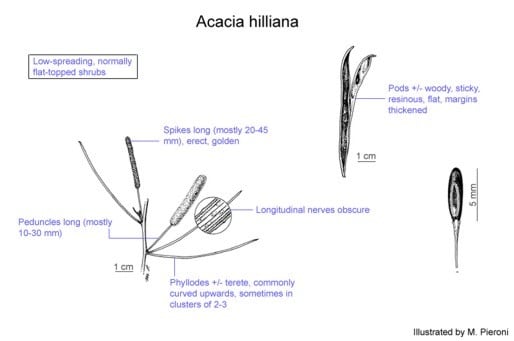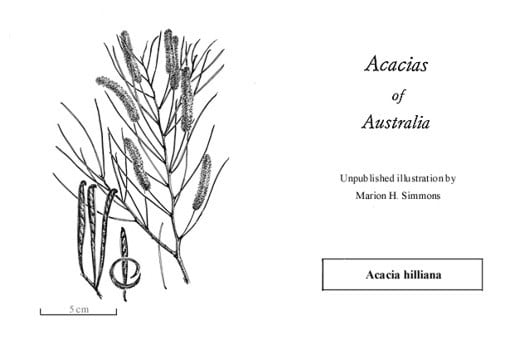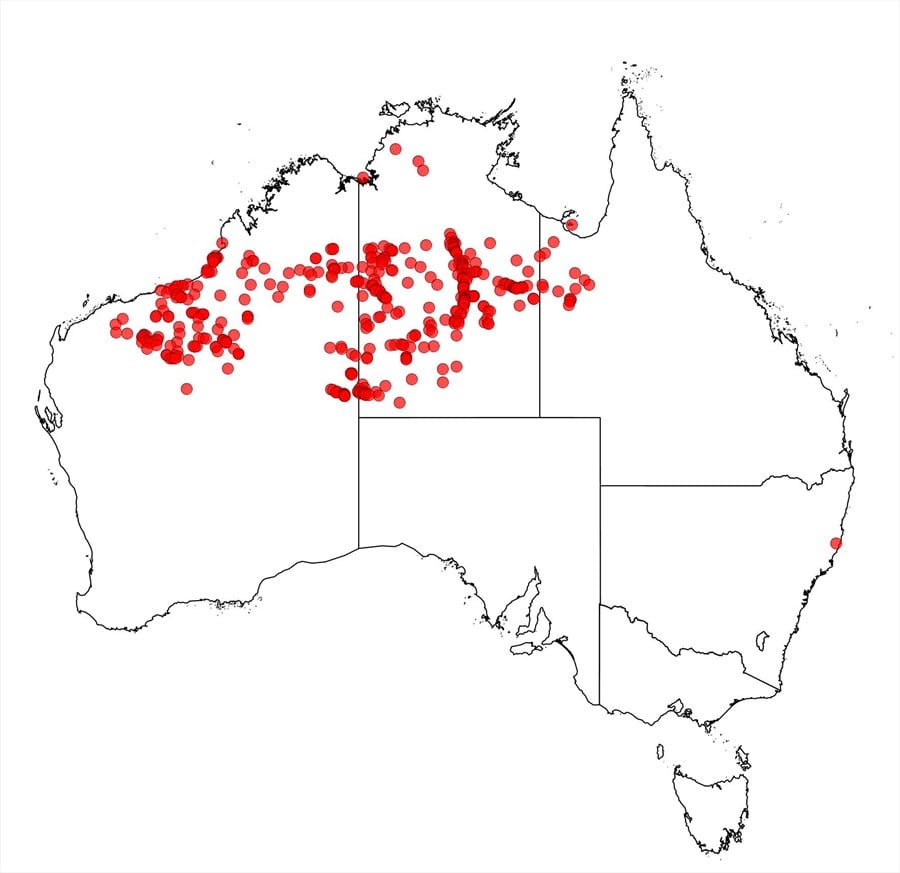Acacia hilliana Maiden
WATTLE
Acacias of Australia
Common Name
Hill's Tabletop Wattle, Flying-saucer Bush
Family
Fabaceae
Distribution
Widespread and quite common in northern and central Australia, extending from the Pilbara region, W.A. through N.T. to NW Qld, between about 17ºS and 25ºS.
Description
Sprawling, semi-prostrate, normally flat-topped, horizontally-branched, resinous, glabrous shrub 0.3–1 (–1.5) m tall and spreading 1–3 (–4–5) m across. Branchlets variably tuberculate, obscurely ribbed. New shoots viscid. Phyllodes solitary at nodes or sometimes in clusters of 2 or 3, commonly shallowly to moderately curved upwards (often curving from near the base), sometimes straight, terete to compressed, rarely flat, 2–6 (–7) cm long, 0.5–1 mm wide, coriaceous, glaucous when mature, usually tuberculate, obscurely multistriate; gland usually 1, inconspicuous, 2.8–13 mm above pulvinus. Spikes 2–4.5 cm long, erect, golden; peduncles 10–30 (–40) mm long. Flowers 5-merous; calyx 0.5–1 mm long, dissected for 2/3–3/4. Pods erect, linear but narrowed towards base, flat, 2–7.7 cm long, 2.5–5 (–6) mm wide, woody, viscid and fragrant (especially when young), dark brown, with oblique nerves, opening elastically from the ±hooked apex (valves recurved following dehiscence); margins thick and pale coloured; with discrete seed-partitions. Seeds oblique to almost longitudinal, laterally compressed, 2.8–5.5 mm long, chestnut to brown; areole light brown to brown, with pale halo bordering the pleurogram; funicle-aril straight and narrowly turbinate.
Phenology
Flowers April–Nov., main flush May–June.
Habitat
Grows in skeletal, red loamy sand or sand on laterite or quartzite, on slopes or ridges, near creeks, inland sand dunes or rocky plains, in open woodland, shrubland or grassland with eucalypts, acacias and spinifex.
Specimens
W.A.: Sir Frederick Ra., J.R.Maconochie 1380 (DNA, NSW); N o f Great Sandy Desert, turnoff to La Grange Mission, I.V.Newman 657 (NSW). N.T.: Churchills Head, 80 km N of Tennant Creek, B.G.Briggs 3691 (DNA, NSW, PERTH, U); 4 miles [6.4 km] NE of Kurundi Stn, M.Lazarides 5872 (CANB, NSW); Highland Rocks area, J.R.Maconochie 1089 (DNA, NSW). Qld: c. 104 km WNW of Mt Isa, L.P.Bailey Q317 (BRI).
Notes
A reputed hybrid between A. hilliana and A. stellaticeps has been collected near the Eighty Mile Beach, W.A. (see A. hilliana × stellaticeps).
A specimen from c. 18 km W of Doomadgee on Corinda road, Qld (S.W.L.Jacobs 1463, NSW), which has fine phyllodes (to 2.8 cm long, 0.5–0.7 mm wide) and calyces to 0.5 mm long with ±free sepals, requires further investigation as to its relationship to A. hilliana.
Acacia hilliana is a relatively invariate species. However, a few Pilbara specimens are slightly atypical in that they lack the small tubercles which are normally scattered over the phyllodes and branchlets (e.g. Wittenoom, W.A., F.Lullfitz L6181, NSW).
Closely allied to Acacia sp. Barklys (J.L.Egan 124) and A. arrecta.
Very attractive when in flower and has horticultural potential for inland gardens. Used widely in the Pilbara, W.A., for mine site rehabilitation.
FOA Reference
Data derived from Flora of Australia Volumes 11A (2001), 11B (2001) and 12 (1998), products of ABRS, ©Commonwealth of Australia
Author
Revised by B.R.Maslin
Dr M.D.Tindale and Dr P.G.Kodela with the assistance of M.Bedward, S.J.Davies, C.Herscovitch, D.A.Keith and/or D.A.Morrison
This identification key and fact sheets are available as a mobile application:
URL: https://apps.lucidcentral.org/wattle/
© Copyright 2018. All rights reserved.
